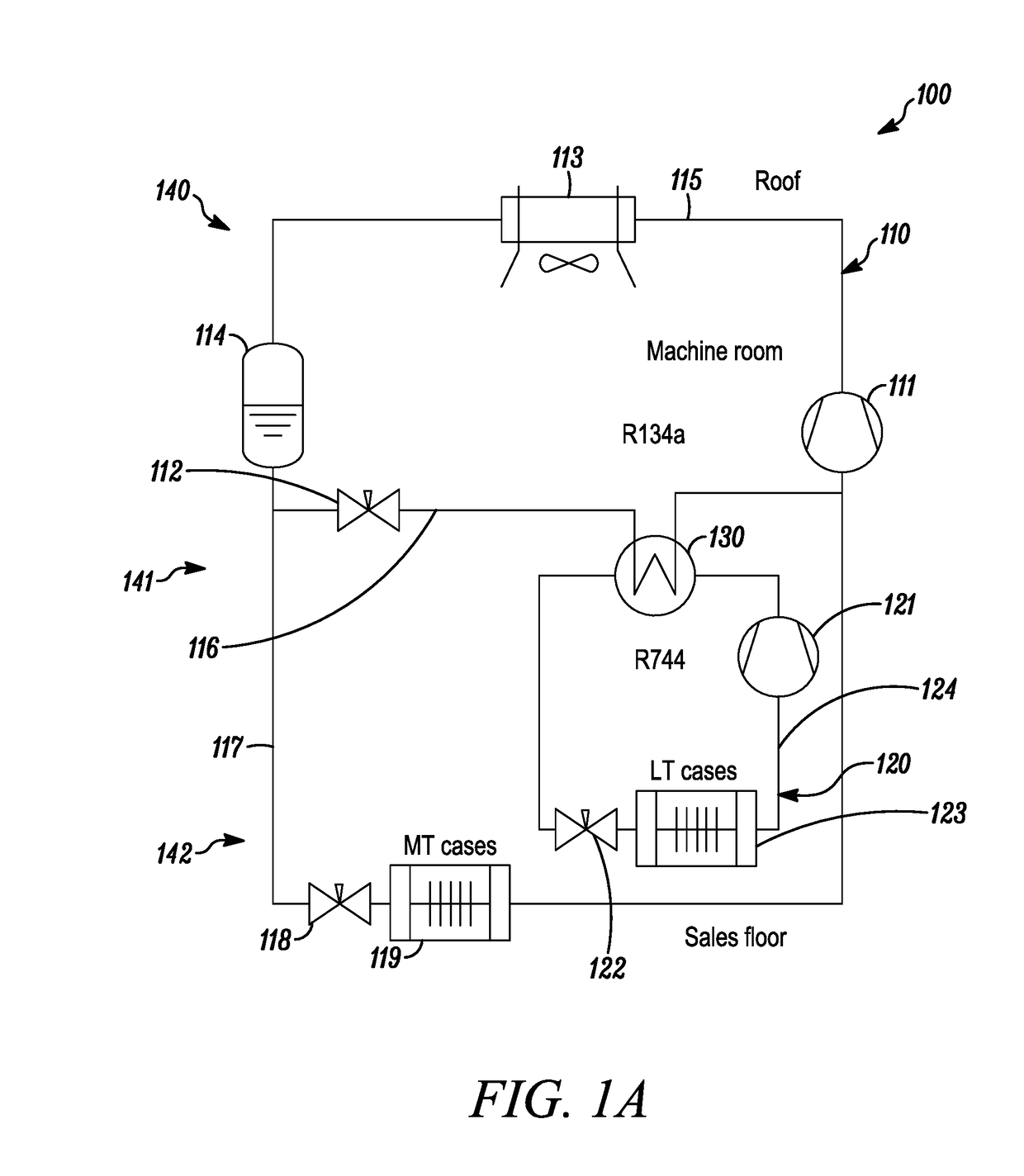Refrigerant, heat transfer compositions, methods, and systems
a heat transfer composition and refrigerant technology, applied in the field of refrigerant, heat transfer composition, methods and systems, can solve the problem of difficult to provide a refrigerant which is non-flammabl
- Summary
- Abstract
- Description
- Claims
- Application Information
AI Technical Summary
Benefits of technology
Problems solved by technology
Method used
Image
Examples
example 1a
mic Glide
[0419]In systems containing direct expansion evaporators, the evaporator manufacturer generally sets a design limit of a pressure drop which is equivalent to a loss of 1° C. to 2° C. in saturation temperature from the inlet to the outlet of the evaporator (Encyclopedia of Two Phase heat transfer and Flow I, John T Thome, chapter 6, p 144).
[0420]The saturation temperature in the evaporator tends to increase for refrigerants with glide. This increase in temperature is equal to the glide of the refrigerant in the evaporator. The actual temperature variation in the evaporator is the net effect of both of these processes. Therefore, a refrigerant with a glide of less than 2° C. in the evaporator will have an almost constant temperature in the evaporator. This will lead to a very efficient heat exchanger design, especially for applications such as reversible heat pumps where the refrigerant flow changes direction in the heat exchanger, depending on the mode of operation (i.e. hea...
example 1b
mic Glide
[0424]The procedure of Example 1A is repeated except of the composition B2. The thermodynamic glide was determined by experimentally measuring the interaction parameters with the binary pairs of refrigerants (HFO-1234ze(E) / HFCO-1233zd(E), HFO-1234ze(E) / CF3I, HFO-1234ze(E) / HFC-227ea, HFCO-1233zd(E) / CF3I, HFC-227ea / CF3I, HFCO-1233zd(E) / HFC-227ea) and using NIST Refprop 9.1 for calculating the difference in bubble (liquid) and dew (vapor) temperatures.
[0425]The observed glide was unexpectedly lower than predicted by the NIST Refprop 9.1 database which uses estimated interaction parameters (without experimental data) between the binary pairs.
TABLE 2Thermodynamic glide of Refrigerant B2Blend B2 (R1234ze(E) / R227ea / CF3I / R1233zd(E)84% / 4.4% / 9.6% / 2%)Thermodynamic glide Thermodynamic glidewith modeled with binary interactionTemperature binary interactiondetermined(° C.)(° C.)experimentally (° C.)401.41.1101.91.402.01.5−102.21.6
[0426]The above data demonstrates that the claimed composi...
example 2a
ty
[0427]Both CF3I and HFCO-1233zd(E) are known to be non-flammable refrigerants, and can act to suppress the flammability of refrigerant blends which contain flammable components.
[0428]As set out in Table 3A below, a binary composition containing HFO-1234ze(E) and CF3I requires at least 35% of CF3I in order to render the composition non-flammable. Furthermore, a binary composition containing HFCO-1233zd(E) and HFO-1234ze(E) requires at least 31% of HFCO-1233zd(E) to render the composition non-flammable. However, the inventors have surprisingly discovered that when CF3I and HFCO-1233zd(E) are both used, the composition requires much less of these components in order to be non-flammable. For example, a composition containing 20% of a combination of HFCO-1233zd(E) and CF3I is non-flammable.
TABLE 3AAssessment of flammabilityRefrigerantFlammability% R1234ze(E)% R1233zd(E)% CF3IComparativeNon-flammable69%31%—C1ComparativeNon-flammable65%—35%C2A3Non-flammable80% 2%18%
PUM
| Property | Measurement | Unit |
|---|---|---|
| GWP | aaaaa | aaaaa |
| GWP | aaaaa | aaaaa |
| GWP | aaaaa | aaaaa |
Abstract
Description
Claims
Application Information
 Login to View More
Login to View More - R&D
- Intellectual Property
- Life Sciences
- Materials
- Tech Scout
- Unparalleled Data Quality
- Higher Quality Content
- 60% Fewer Hallucinations
Browse by: Latest US Patents, China's latest patents, Technical Efficacy Thesaurus, Application Domain, Technology Topic, Popular Technical Reports.
© 2025 PatSnap. All rights reserved.Legal|Privacy policy|Modern Slavery Act Transparency Statement|Sitemap|About US| Contact US: help@patsnap.com



